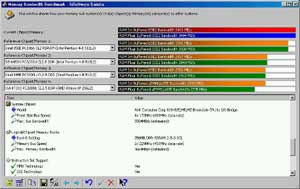|
|
Advertisement:
|
|
Abit BD7-II RAID (i845E P4) Motherboard |
|
Join the community - in the OCAU Forums!
|
Overclocking with the P4 stock HSF
Overclocking with the P4 stock HSF:
Keeping the 3:4 ratio, we started increasing the FSB and RAM frequency until we reached staggering FSB 173 MHz / RAM 229 MHz. At this RAM frequency we got an eye popping Sandra bandwidth of around 3500 MB/sec. This puts the tested system close to RAMBUS RIMM 1060/16 bit. Naturally the 3DMark 2001 score soared and we came with our GF3 TI500 close to the 11,000 mark in default settings. Content Creation 2002 and Business Winstone 2001 showed even bigger performance jumps. The later benchmarks are a much better indicator for overall systems performance than 3DMark 2001 which is simulating only a gaming environment and mainly benchmarking the boards graphic subsystem.

Keeping the 3:4 ratio, we were at the end with a FSB frequency of 173 MHz because the RAM frequency would not go higher. Naturally it is difficult to exceed a RAM frequency of 229 MHz, even with the formidable generic Samsung PC 2700 with TBC3 modules. This is PC 2700/DDR333 and to be able to run it as PC458 (2 x 229 MHz) is simply astounding. We scaled the CPU/RAM ratio back to a 1:1 and continued to increase the FSB until we reached 17x 173 MHz and a CPU frequency of 2941 MHz. Then the system became instable and we had the feeling that the 15% on-top voltage the current BD7-II BIOS is offering are not enough and holding our P4 2.6 back. We therefore applied the well known P4 pin wire mod, as explained here. This worked like a shot in the arm and pushed the frequency up to dazzling 3068 MHz. In order to run all our benchmarks we had to scale back to 3026 MHz, though. This is an amazing result considering that we used the Intel stock HSF that runs with a 2,200 rpm fan basically silent and comes with a cheaply made aluminum sink.
The results at 3026 MHz when running FSB and RAM synchronous at 178 MHz are shown in the tables below. Depending on the application and type of job on hand it might be more beneficial to run the P4 and the RAM asynchronous at 3:4 and a lower CPU frequency than going for a higher CPU frequency and running CPU and RAM synchronous at 1:1. The much higher bandwidth when running CPU:RAM at 3:4 is providing better overall system performance than with a higher clocked CPU at 1:1. At a CPU frequency of 2941 MHz (17x173 MHz) and a RAM frequency of 229 MHz we achieved higher scores with Content Creation and Business Winstone than at 3026 (17 x 178) MHz running CPU:RAM at 1:1. We recommend therefore to carefully check with benchmarks what is the better setting: 1:1 enabling a higher CPU frequency or 3:4 with a higher RAM frequency. We feel it is more beneficial to run the BD7-II (and probably any other 845E board) asynchronous. This will not provide for the maximum possible CPU frequency but better overall system performance through higher bandwidth.
We noticed that the BD7-II Northbridge becomes increasingly hot when passing a FSB frequency of 170 MHz. We therefore decided to install a card cooler (as shown below) with 2 x 80 mm fans moving around 80 CFM in total. This way we kept the Northbridge but also the mosfets, the capacitors and of course the video card close to room temperature. We recommend having a watchful eye on the Northbridge temperature when going into extreme overclocking. The BD7-II Northbridge heatsink is simply overcharged with handling FSB frequencies in access of 170 MHz (around 2900 MHz) without a fan. This is not to blame on ABIT or the BD7-II, because at 2900 MHz, the CPU and the board are already running far out of specification.
|
|
Advertisement:
All original content copyright James Rolfe.
All rights reserved. No reproduction allowed without written permission.
Interested in advertising on OCAU? Contact us for info.
|

|


